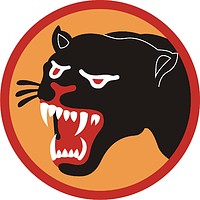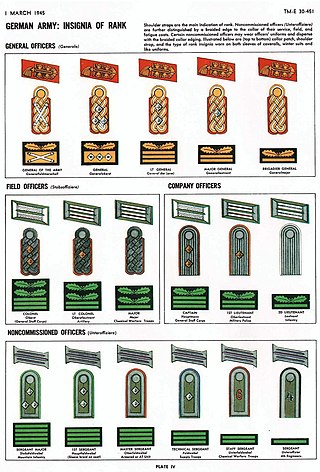Shoulder sleeve insignia (SSI) are cloth emblems worn on the shoulders of US Army uniforms to identify the primary headquarters to which a soldier is assigned. [1] [2]

III Corps is a corps of the United States Army headquartered at Fort Cavazos, Texas. It is a major formation of the United States Army Forces Command.

The Twelfth United States Army Group was the largest and most powerful United States Army formation ever to take to the field, commanding four field armies at its peak in 1945: First United States Army, Third United States Army, Ninth United States Army and Fifteenth United States Army. The order of battle across the four armies comprised 12 corps, containing a total of 48 divisions. Formed eight days after the Normandy landings, it initially controlled the First and the Third US Armies. Through various configurations in 1944 and 1945, the Twelfth US Army Group controlled the majority of American forces on the Western Front. It was commanded by General Omar Bradley with its headquarters established in London on 14 July 1944.

The 78th Training Division (Operations) ("Lightning") is a unit of the United States Army which served in World War I and World War II as the 78th Infantry Division, and currently trains and evaluates units of the United States Army Reserve for deployment.

The 66th Infantry Division was a unit of the United States Army during World War II. Activated 15 April 1943, the division trained at Camp Blanding, Florida, and was later transferred to Camp Robinson, Arkansas and then later to Camp Rucker, Alabama before being shipped overseas to England on 26 November 1944. Commanded by Maj. Gen. Herman F. Kramer, the 66th Infantry Division's main role in World War II was containing and eliminating the remaining pockets of German soldiers in Northern France.

The 81st Readiness Division ("Wildcat") was a formation of the United States Army originally organized as the 81st Infantry Division during World War I. After World War I, the 81st Division was allotted to the Organized Reserve as a "skeletonized" cadre division. In 1942, the division was reactivated and reorganized as the 81st Infantry Division, and served in the Pacific during World War II. After World War II, the 81st Infantry Division was allotted to the Organized Reserve as a Class C cadre division, and stationed at Atlanta, Georgia. The 81st Infantry Division saw no active service during the Cold War, and was inactivated in 1965.

The 83rd Infantry Division ("Thunderbolt") was a formation of the United States Army in World War I and World War II.

The 30th Infantry Division was a unit of the Army National Guard in World War I and World War II. It was nicknamed the "Old Hickory" division, in honor of President Andrew Jackson. The Germans nicknamed this division "Roosevelt's SS". The 30th Infantry Division was regarded by a team of historians led by S.L.A. Marshall as the number one American infantry division in the European Theater of Operations (ETO), involved in 282 days of intense combat over a period from June 1944 through April 1945. In the present day the 30th Armored Brigade Combat Team is now a part of the North Carolina National Guard and their most recent combat deployment was in 2019.

Shoulder sleeve insignia (SSI) are distinctive cloth patches worn on the left sleeve of the United States Army uniform just below the shoulder seam by soldiers assigned to divisions, corps, armies, and other specifically authorized organizations. They are also worn on the right sleeve by soldiers to indicate former overseas service with certain units during periods of U.S. military operations in hostile conditions (MOHC).
The United States Army in World War II used a variety of standard and non-standard dress and battle uniforms, which often changed depending upon the theater of war, climatic environment, and supply exigencies.

II Field Force, Vietnam was a United States Army Corps-level command during the Vietnam War.
Shoulder sleeve insignia (SSI) are cloth emblems worn on the shoulders of US Army uniforms to identify the primary headquarters to which a soldier is assigned. The SSI of some army divisions have become known in popular culture.

XIX Corps was a corps-sized formation of the United States Army, initially allocated to the Organized Reserves in California and seven other western and northwestern states. Meanwhile, the Headquarters, III Armored Corps was formed at Camp Polk, Louisiana on July 7, 1942 under the command of Major General Willis D. Crittenberger during World War II. It was activated on August 20 the same year at Camp Polk. The XIX Corps was officially disbanded on October 1, 1943 from the Organized Reserves. On October 10, 1943, the Headquarters, III Armored Corps was reorganized and re-designated as Headquarters and Headquarters Company, XIX Corps which formed the activated XIX Corps. It fought as part of the First and Ninth Armies, fighting on the Western Front of World War II. Disbanded on 5 September 1945 in France, it was reconstituted on 12 July 1950 in the Army of the United States. It was allotted to the Regular Army in October 1959 and activated on 1 November that year at Fort Chaffee, Arkansas. It was inactivated on 1 April 1968 at Fort Chaffee.

The Heer as the German army and part of the Wehrmacht inherited its uniforms and rank structure from the Reichsheer of the Weimar Republic (1921–1935). There were few alterations and adjustments made as the army grew from a limited peacetime defense force of 100,000 men to a war-fighting force of several million men.

The Armor Branch of the United States Army is an active armored warfare combat arms branch.
The 16th Field Artillery Regiment is a field artillery regiment of the United States Army. The regiment served with the 4th Division in World War II and with the 4th and 8th Divisions between the World Wars. As the 16th Armored Field Artillery Battalion, it served with the 9th Armored Division during World War II, and with the 2nd Armored Division after the war. Designated a parent regiment under the Combat Arms Regimental system, and later the U.S. Army Regimental System, since 1957, regimental elements have served with the 1st, 2nd and 4th Armored Divisions; the 4th, 8th, and 81st Infantry Divisions; and the 1st Cavalry Division. Regimental elements have participated in combat in Vietnam, and in Operation Iraqi Freedom. The regiment currently has a single active battalion, the 3rd Battalion, 16th Field Artillery, assigned to the 2nd Brigade Combat Team, 1st Cavalry Division and stationed at Fort Hood, Texas.

The United States Army Central, formerly the Third United States Army, commonly referred to as the Third Army and as ARCENT, is a military formation of the United States Army that saw service in World War I and World War II, in the 1991 Gulf War, and in the coalition occupation of Iraq. It is best known for its campaigns in World War II under the command of General George S. Patton.